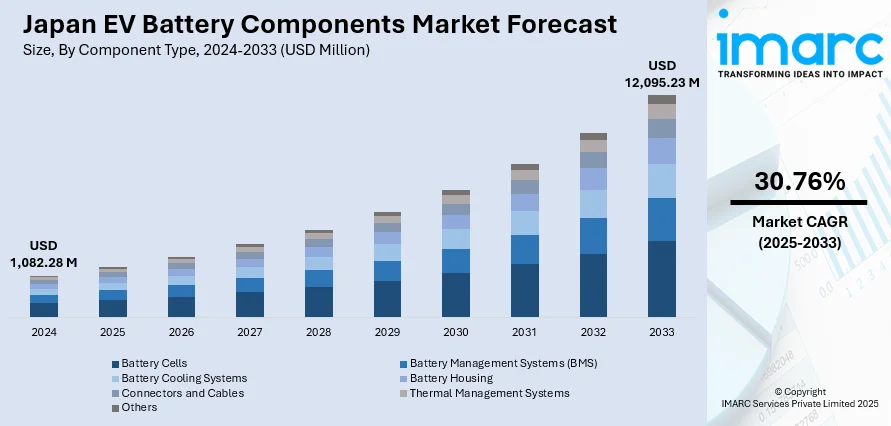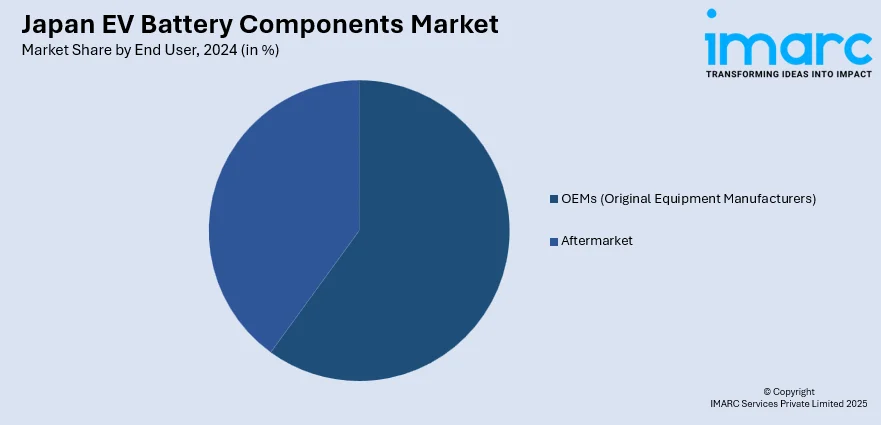
Japan EV Battery Components Market Size, Share, Trends and Forecast by Component Type, Battery Type, Vehicle Type, Propulsion Type, End User, and Region, 2025-2033
Japan EV Battery Components Market Overview:
The Japan EV battery components market size reached USD 1,082.28 Million in 2024. Looking forward, IMARC Group expects the market to reach USD 12,095.23 Million by 2033, exhibiting a growth rate (CAGR) of 30.76% during 2025-2033. The market is propelled by major developments in solid-state batteries, advanced battery management systems, and high-performance, lightweight materials. These developments enhance energy density, safety, and efficiency, further strengthening Japan's dominance in EV innovation. As these technologies mature and advance, they will have a pivotal role in growing market demand and influencing the future of electric mobility. Combined, these developments are likely to boost the Japan EV battery components market share enormously in the coming years.
|
Report Attribute
|
Key Statistics
|
|---|---|
|
Base Year
|
2024 |
|
Forecast Years
|
2025-2033
|
|
Historical Years
|
2019-2024
|
| Market Size in 2024 | USD 1,082.28 Million |
| Market Forecast in 2033 | USD 12,095.23 Million |
| Market Growth Rate 2025-2033 | 30.76% |
Japan EV Battery Components Market Trends:
Advancements in Solid-State Battery Technology
Japan remains at the forefront of innovation in solid-state battery technology, a development that holds the potential to revolutionize electric vehicle (EV) batteries. In contrast to traditional liquid-based lithium-ion batteries, solid-state batteries employ solid electrolytes, which provide greater safety through electrolyte leakage and fire risk reduction. Solid-state batteries also facilitate greater energy densities, which will let EVs cover more distances on a single charge. In addition, solid-state technology enables quicker charging times, which responds to the needs of consumers for convenience and efficiency. Japan EV battery components market growth is being driven by continued investments in research and material development, with an emphasis on enhancing electrolyte stability and compatibility of interfaces. For example, in June 2023, Toyota launched pioneering EV technologies for 1,000 km range, AI-driven aerodynamics, and OTA updates in full, a big step in its battery and hydrogen mobility strategy. Furthermore, these developments are imperative to the production of commercially successful batteries that achieve longevity coupled with high performance. Japan's strategic focus on solid-state batteries not only fortifies its home EV sector but also stabilizes its role as an international technology leader of next-generation battery components.

Embedding Sophisticated Battery Management Systems (BMS)
Battery Management Systems (BMS) are becoming more advanced within Japan's electric vehicle supply chain. They are also critical in tracking battery health, controlling charging cycles, and providing operational security through temperature, voltage, and current regulation. Japan is seeing artificial intelligence (AI) based diagnostics and Internet of Things (IoT) connectivity integrated into BMS to support real-time monitoring and predictive maintenance that lengthens battery life and performance reliability by as much as several times. Advanced BMS technology supports adaptive thermal balancing and energy optimization, guaranteeing improved safety and efficiency. This high level of smart battery management is crucial as the market for EVs grows, and it serves to solve the challenges of bigger battery packs and mixed driving conditions. The continuous improvement of BMS contributes to the overall development of the Japan EV battery components market by promoting increased consumer confidence and ensuring compliance with regulatory requirements in battery safety standards.
Emphasis on Lightweight and High-Performance Battery Materials
The Japan EV battery components industry is more and more concentrated on the use and development of high-performance and light-weight materials that make vehicles more efficient and batteries more effective. New technologies in cathode and anode material development seek higher energy density without sacrificing durability and safety. With less weight in battery parts, vehicle weight comes down overall, resulting in better energy efficiency and longer driving distances. In addition, innovative materials assist in better thermal management, which is vital to ensure battery stability across various environmental conditions. For instance, in September 2024, Asahi Kasei introduced a new grade of LASTAN™ nonwoven fabric, providing flame resistance up to 1,300°C and 3.5 kV insulation, supporting EV battery safety and manufacturability. Moreover, this emphasis is consistent with Japan's wider environmental and sustainability strategies, as lighter batteries reduce the carbon impact of electric vehicles. The need for such materials has a direct effect on the Japan EV battery components market growth since firms aim to supply innovative solutions in terms of ever-tighter performance, safety, and environmental requirements, cementing Japan's position in the world EV battery supply chain.
Japan EV Battery Components Market Segmentation:
IMARC Group provides an analysis of the key trends in each segment of the market, along with forecasts at the country and regional levels for 2025-2033. Our report has categorized the market based on component type, battery type, vehicle type, propulsion type, and end user.
Component Type Insights:
- Battery Cells
- Battery Management Systems (BMS)
- Battery Cooling Systems
- Battery Housing
- Connectors and Cables
- Thermal Management Systems
- Others
The report has provided a detailed breakup and analysis of the market based on the component type. This includes battery cells, battery management systems (BMS), battery cooling systems, battery housing, connectors and cables, thermal management systems, and others.
Battery Type Insights:
- Lithium-Ion Batteries
- Nickel-Metal Hydride Batteries
- Solid-State Batteries
- Lead-Acid Batteries
A detailed breakup and analysis of the market based on the battery type have also been provided in the report. This includes lithium-ion batteries, nickel-metal hydride batteries, solid-state batteries, and lead-acid batteries.
Vehicle Type Insights:
- Passenger Vehicles
- Commercial Vehicles
- Two-Wheelers
- Three-Wheelers
The report has provided a detailed breakup and analysis of the market based on the vehicle type. This includes passenger vehicles, commercial vehicles, two-wheelers, and three-wheelers.
Propulsion Type Insights:
- Battery Electric Vehicles (BEVs)
- Plug-in Hybrid Electric Vehicles (PHEVs)
- Hybrid Electric Vehicles (HEVs)
A detailed breakup and analysis of the market based on the propulsion type have also been provided in the report. This includes battery electric vehicles (BEVs), plug-in hybrid electric vehicles (PHEVs), and hybrid electric vehicles (HEVs).
End User Insights:

- OEMs (Original Equipment Manufacturers)
- Aftermarket
The report has provided a detailed breakup and analysis of the market based on the end user. This includes OEMs (original equipment manufacturers) and aftermarket.
Regional Insights:
- Kanto Region
- Kansai/Kinki Region
- Central/ Chubu Region
- Kyushu-Okinawa Region
- Tohoku Region
- Chugoku Region
- Hokkaido Region
- Shikoku Region
The report has also provided a comprehensive analysis of all the major regional markets, which include Kanto region, Kansai/Kinki region, Central/Chubu region, Kyushu-Okinawa region, Tohoku region, Chugoku region, Hokkaido region, and Shikoku region.
Competitive Landscape:
The market research report has also provided a comprehensive analysis of the competitive landscape. Competitive analysis such as market structure, key player positioning, top winning strategies, competitive dashboard, and company evaluation quadrant has been covered in the report. Also, detailed profiles of all major companies have been provided.
Japan EV Battery Components Market News:
- In May 2025, TDK stepped up the launch of its next-generation silicon anode batteries ahead of schedule, fueled by robust smartphone demand, and will spend more than half of its capital spending in battery and energy technologies between now and 2028.
- In June 2024, Honda and Mitsubishi Corporation revealed the formation of ALTNA Co., Ltd., a 50/50 joint venture that will begin operations in July 2024. ALTNA will specialize in battery leasing, repurposing, and intelligent charging services to maximize EV expense benefits, extend battery lifecycle value, and contribute to Japan's decarbonization.
Japan EV Battery Components Market Report Coverage:
| Report Features | Details |
|---|---|
| Base Year of the Analysis | 2024 |
| Historical Period | 2019-2024 |
| Forecast Period | 2025-2033 |
| Units | Million USD |
| Scope of the Report |
Exploration of Historical Trends and Market Outlook, Industry Catalysts and Challenges, Segment-Wise Historical and Future Market Assessment:
|
| Component Types Covered | Battery Cells, Battery Management Systems (BMS), Battery Cooling Systems, Battery Housing, Connectors and Cables, Thermal Management Systems, Others |
| Battery Types Covered | Lithium-Ion Batteries, Nickel-Metal Hydride Batteries, Solid-State Batteries, Lead-Acid Batteries |
| Vehicle Types Covered | Passenger Vehicles, Commercial Vehicles, Two-Wheelers, Three-Wheelers |
| Propulsion Types Covered | Battery Electric Vehicles (BEVs), Plug-in Hybrid Electric Vehicles (PHEVs), Hybrid Electric Vehicles (HEVs) |
| End Users Covered | OEMs (Original Equipment Manufacturers), Aftermarket |
| Regions Covered | Kanto Region, Kansai/Kinki Region, Central/Chubu Region, Kyushu-Okinawa Region, Tohoku Region, Chugoku Region, Hokkaido Region, Shikoku Region |
| Customization Scope | 10% Free Customization |
| Post-Sale Analyst Support | 10-12 Weeks |
| Delivery Format | PDF and Excel through Email (We can also provide the editable version of the report in PPT/Word format on special request) |
Key Questions Answered in This Report:
- How has the Japan EV battery components market performed so far and how will it perform in the coming years?
- What is the breakup of the Japan EV battery components market on the basis of component type?
- What is the breakup of the Japan EV battery components market on the basis of battery type?
- What is the breakup of the Japan EV battery components market on the basis of vehicle type?
- What is the breakup of the Japan EV battery components market on the basis of propulsion type?
- What is the breakup of the Japan EV battery components market on the basis of end user?
- What is the breakup of the Japan EV battery components market on the basis of region?
- What are the various stages in the value chain of the Japan EV battery components market?
- What are the key driving factors and challenges in the Japan EV battery components?
- What is the structure of the Japan EV battery components market and who are the key players?
- What is the degree of competition in the Japan EV battery components market?
Key Benefits for Stakeholders:
- IMARC’s industry report offers a comprehensive quantitative analysis of various market segments, historical and current market trends, market forecasts, and dynamics of the Japan EV battery components market from 2019-2033.
- The research report provides the latest information on the market drivers, challenges, and opportunities in the Japan EV battery components market.
- Porter's five forces analysis assist stakeholders in assessing the impact of new entrants, competitive rivalry, supplier power, buyer power, and the threat of substitution. It helps stakeholders to analyze the level of competition within the Japan EV battery components industry and its attractiveness.
- Competitive landscape allows stakeholders to understand their competitive environment and provides an insight into the current positions of key players in the market.
Need more help?
- Speak to our experienced analysts for insights on the current market scenarios.
- Include additional segments and countries to customize the report as per your requirement.
- Gain an unparalleled competitive advantage in your domain by understanding how to utilize the report and positively impacting your operations and revenue.
- For further assistance, please connect with our analysts.
 Request Customization
Request Customization
 Speak to an Analyst
Speak to an Analyst
 Request Brochure
Request Brochure
 Inquire Before Buying
Inquire Before Buying




.webp)




.webp)












